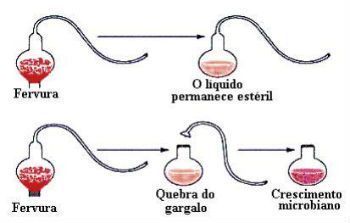Abiogenesis and biogenesis are two theories formulated to explain the origin of life on Earth.
The question of how life on Earth came about has always intrigued scientists. To answer that question, they formulated hypotheses and carried out different types of experiments.
The theory of abiogenesis was the first to emerge, it described that life arose spontaneously.
Scientists defending abiogenesis believed that life could arise spontaneously. For example, swans came from leaves that fell in lakes and mice came from dirty, damp clothes mixed with wheat seeds.
Although today seems an absurd theory, abiogenesis has long been accepted to explain the origin of living beings.
Some scientists at the time also did not believe that life could come spontaneously. Thus, the theory of biogenesis arose, which stated that all forms of life could only be originated from pre-existing ones.
Differences between Abiogenesis and Biogenesis
Abiogenesis and biogenesis are two opposite theories to explain the rise of life.
Find out what each one is and their differences:
- Abiogenesis : Living beings originated from raw, lifeless matter. Theory overturned through experiments.
- Biogenesis : Living beings originate from other pre-existing living beings. Currently accepted to explain the emergence of living beings.
Abiogenesis x Biogenesis
Several scientists have tested the theories of abiogenesis and biogenesis through experiments.
In 1668, the Italian doctor and scientist Francesco Redi carried out an experiment placing animal carcasses in flasks with wide mouths. Of these, some were sealed with thin gauze and others left open.
After a few days, he noticed that worms appeared in the open flasks. While in the closed bottles there were no worms.

Redi concluded that the fact that flies could not enter closed jars prevented worms from appearing. Flies are responsible for the emergence of worms. With Redi’s experiment , abiogenesis started to lose credibility.
In 1745, John Needham conducted an experiment that again reinforced the theory of Abiogenesis.
He heated nutritious broths in bottles that were closed and heated again. Its intention was to prevent the entry and proliferation of microorganisms. Over the days, microorganisms appeared in the flasks and Needham concluded that his experiment was the result of abiogenesis.
In 1770, Lazzaro Spallanzani claimed that Needham did not heat the nutrient broth long enough to destroy the bacteria. To prove that he was right, Spallanzani performed the same experiment as Needham. However, he heated the broth for a longer time. The result was that no bacteria appeared.
Once again the theory of abiogenesis lost its credibility.
In 1862, the theory of abiogenesis was definitively overthrown by Louis Pasteur .
Pasteur carried out experiments with nutritious broths in swan neck balloons. After boiling the juice, the neck of the balloon was broken and microorganisms appeared. In balloons without a broken neck, the microorganisms did not appear.

Pasteur proved that boiling did not destroy any kind of “active force”. In addition, it was enough to break the neck of the balloon for microorganisms to appear, through contact with air.
